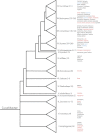The Cucurbitaceae of India: Accepted names, synonyms, geographic distribution, and information on images and DNA sequences
- PMID: 23717193
- PMCID: PMC3652411
- DOI: 10.3897/phytokeys.20.3948
The Cucurbitaceae of India: Accepted names, synonyms, geographic distribution, and information on images and DNA sequences
Abstract
The most recent critical checklists of the Cucurbitaceae of India are 30 years old. Since then, botanical exploration, online availability of specimen images and taxonomic literature, and molecular-phylogenetic studies have led to modified taxon boundaries and geographic ranges. We present a checklist of the Cucurbitaceae of India that treats 400 relevant names and provides information on the collecting locations and herbaria for all types. We accept 94 species (10 of them endemic) in 31 genera. For accepted species, we provide their geographic distribution inside and outside India, links to online images of herbarium or living specimens, and information on publicly available DNA sequences to highlight gaps in the current understanding of Indian cucurbit diversity. Of the 94 species, 79% have DNA sequences in GenBank, albeit rarely from Indian material. The most species-rich genera are Trichosanthes with 22 species, Cucumis with 11 (all but two wild), Momordica with 8, and Zehneria with 5. From an evolutionary point of view, India is of special interest because it harbors a wide range of lineages, many of them relatively old and phylogenetically isolated. Phytogeographically, the north eastern and peninsular regions are richest in species, while the Jammu Kashmir and Himachal regions have few Cucurbitaceae. Our checklist probably underestimates the true diversity of Indian Cucurbitaceae, but should help focus efforts towards the least known species and regions.
Keywords: Conservation; Cucumis wild species; Cucurbitaceae tribal classification; India’s phytogeographic regions; Trichosanthes; revised generic boundaries.
Figures
References
-
- Ali Khan A. (2002)Actinostemma tenerum Griff., Cucurbitaceae, a new phytogeographic record from Aligarh, Uttar Pradesh. J. Bombay Nat. Hist. Soc. 99. (2): 365–366.
-
- Ali MA, Pandey AK, Lee J. (2009) Taxonomic relationships among the genera of subfamily Cucurbitoideae (family Cucurbitaceae) from India inferred from ITS sequences of nuclear ribosomal DNA. Phytomorphology 59(3&4): 127–140.
-
- Bhandari MM, Singh D. (1964) Dactyliandra (Hook.f.) Hook. F.: A cucurbitaceous genus new to the Indian flora. Kew Bulletin 19 (1): 133-138 doi: 10.2307/4108301 - DOI
-
- Chakravarty HL. (1946) Studies in Indian Cucurbitaceae with special remarks on distribution and uses of economic species. Indian Journal of Agricultural Science 16: 47-50
-
- Chakravarty HL. (1959) Monograph of Indian Cucurbitaceae (taxonomy and distribution). Records of the Botanical Survey of India 17: 1-234
LinkOut - more resources
Full Text Sources
Other Literature Sources

